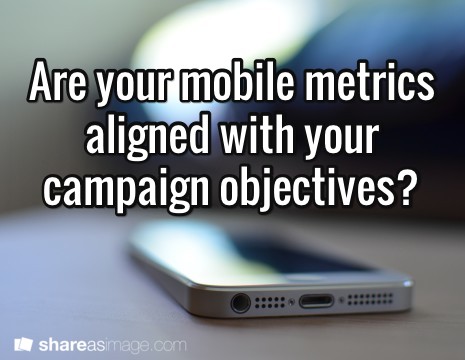
Legend has it that in the 12th century King Henry I declared that a yard was the distance from his nose to his outstretched thumb. The issues this would have caused are both amusing and innumerable. It wasn’t until Richard the Lionheart instituted the Magna Carta that measurements were standardised, stating “There shall be but one Measure throughout the Realm!” – Most of us in the digital advertising industry are looking forward to yelling that out of our office windows. I would just add an additional caveat – “and let it be the best!”
Although setting clear objectives prior to launching a campaign has been standard practice in advertising for decades, the variety of digital platforms available to a campaign make that objective-setting even more critical. When it comes to mobile advertising metrics, recent data from our 2014 IAB/TNS Mobile Landscape Study highlights just how important it is to ensure your metrics match your objectives – and the methods for discerning just what those metrics should be are evolving.
IAB Australia, along with several key publishers, has launched the Mobile Audience Panel Measurement Pilot to address the short to medium term requirements of the online industry, delivering both site and application mobile usage data at a brand level to advertisers. The first top line market data will be published in Q2 2014, and we anticipate that this data will be invaluable towards the development of a mobile measurement currency.
Still, we need to examine our mobile measurement habits. When our survey asked the question: What have been the objectives of mobile advertising activities you’ve been involved with over the past year? Increasing brand awareness was at the top of the list (see graph below). Yet, when the same respondents were asked which key measures were used to assess performance against the objectives – click-through-rates (CTRs) were number one followed by interactions, and app downloads were the top three, while brand impact studies and attribution modelling ranked lowest.

Surely, brand impact studies and attribution modelling would offer the most complete picture of brand awareness in a target audience. The shortcomings of click-through data have been well documented as an ineffective method for measuring campaign impact. With mobile advertising growing at a rapid pace – the same study pointing out that nearly half of all display campaigns have mobile components today, a figure expected to grow by 43 percent in 2016 – why would the majority of agencies be using outdated metrics to measure their success?
One possibility: it’s easy and available. When Richard the Lionheart made his measurement decree, it didn’t take hold over night. Click-through data – as imperfect as it is – is a measurement comfort zone. It’s true that metrics like attribution modelling, which analyse the degree to which cross-platform media exposure across channels generates different bottom line results, like purchasing, are more expensive and can be difficult to implement. As an industry, we need to do more to make the best metrics more approachable, and phase out the metrics that no longer serve us.
Why is it so important to connect your biggest objectives to the best metrics? As I see it, there are two critical reasons. Firstly, clients increasingly want the most complete picture of their campaign’s impact, and are no longer satisfied with click-through data. When agencies use metrics most suited to the campaign objectives – the clearer the picture of ROI will be for the client, bringing agencies closer to the brands.
Secondly, it’s very important not to undervalue what you’re getting out of your mobile ad-spend. Click through data won’t give you an accurate picture of the impact of your campaign, period. Agencies, publishers and brands are all best served by data that can directly link marketing activities to outcomes. Online advertising came of age in the era of click-through data, but we can do so much better. Mobile advertising should benefit from all of the innovations in audience measurements and more sophisticated marketing modelling, it’s the only way to maximize its meteoric growth.
For our part, the upcoming IAB measurement contract tender is leading the industry to a digital audience solution that works across desktop and mobile consumer usage. Additionally, the recently updated Digital Brand Ad Effectiveness Best Practice Guidelines offer valuable advice for optimizing research and measurement in a campaign, and how to set campaign objectives that will provide the best insights.
It’s an exciting time for both mobile advertising and measurement, and when we effectively combine the two, I believe we will see mobile ad spend rise to levels that match the opportunities in mobile advertising.
